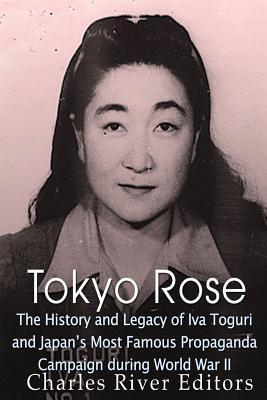Tokyo Rose: The History and Legacy of Iva Toguri and Japan's Most Famous Propaganda Campaign during World War II

Tokyo Rose: The History and Legacy of Iva Toguri and Japan's Most Famous Propaganda Campaign during World War II
*Includes contemporary accounts about Iva Toguri and her trial
*Includes online resources and a bibliography for further reading The subtle art of propaganda campaigns directed against one's enemies has been a feature of war since ancient times. However, its potential for mass psychological impact created a new paradigm with the invention of modern electronic communications. Every nation involved in the Second World War, whether of the Allies or Axis, possessed an agency devoted to the mission of demoralizing and misleading the enemy, and virtually all artistic genres participated. In America, Frank Capra, director of beloved films such as It's a Wonderful Life and Mr. Smith Goes to Washington, also directed wartime films demonizing the Germanic personality. In a notable example, a training film warns young GIs that German women do not share a natural capacity for human ethics common to higher civilizations and therefore must be avoided. Theodore Geisel, beloved to Western children as Dr. Seuss, wrote stories stereotyping, demeaning, and demonizing the Japanese, complete with insulting and offensive illustrations. Radio Free Europe filled the airwaves with pro-western speech as a counter to communist expansion and diatribes about the 'otherness' of enemy societies.
Japanese propaganda was not a new invention to be used only against the United States. While the U.S. lacked any international audience, preaching mostly to its own, Japan disseminated propagandistic material throughout all the Asian countries it eventually intended to conquer. In the years leading up to World War II, an intense study led by the Japanese government delved into the details of American culture and customs, particularly those dear to men of fighting age. Both countries, at one time or another, assaulted the Chinese world image as represented by "yellow monkeys," or the "yellow peril." Both the U.S. and Japan made excellent use of the "war poster," but among the most striking was an American-created image of a naked white woman slung over the shoulder of a Japanese officer, as if the entire American nation would be raped if the empire was allowed to prevail. By 1945, Japanese animation was in full swing, producing films such Momotaro: Sacred Sailors. American officers are portrayed as bulbous idiots as the noble Japanese seamen save the island. By the end of the war, the U.S. instructed all copies to be destroyed, but one mysteriously survived.
PRP: 79.36 Lei
Acesta este Prețul Recomandat de Producător. Prețul de vânzare al produsului este afișat mai jos.
71.42Lei
71.42Lei
79.36 LeiLivrare in 2-4 saptamani
Descrierea produsului
*Includes contemporary accounts about Iva Toguri and her trial
*Includes online resources and a bibliography for further reading The subtle art of propaganda campaigns directed against one's enemies has been a feature of war since ancient times. However, its potential for mass psychological impact created a new paradigm with the invention of modern electronic communications. Every nation involved in the Second World War, whether of the Allies or Axis, possessed an agency devoted to the mission of demoralizing and misleading the enemy, and virtually all artistic genres participated. In America, Frank Capra, director of beloved films such as It's a Wonderful Life and Mr. Smith Goes to Washington, also directed wartime films demonizing the Germanic personality. In a notable example, a training film warns young GIs that German women do not share a natural capacity for human ethics common to higher civilizations and therefore must be avoided. Theodore Geisel, beloved to Western children as Dr. Seuss, wrote stories stereotyping, demeaning, and demonizing the Japanese, complete with insulting and offensive illustrations. Radio Free Europe filled the airwaves with pro-western speech as a counter to communist expansion and diatribes about the 'otherness' of enemy societies.
Japanese propaganda was not a new invention to be used only against the United States. While the U.S. lacked any international audience, preaching mostly to its own, Japan disseminated propagandistic material throughout all the Asian countries it eventually intended to conquer. In the years leading up to World War II, an intense study led by the Japanese government delved into the details of American culture and customs, particularly those dear to men of fighting age. Both countries, at one time or another, assaulted the Chinese world image as represented by "yellow monkeys," or the "yellow peril." Both the U.S. and Japan made excellent use of the "war poster," but among the most striking was an American-created image of a naked white woman slung over the shoulder of a Japanese officer, as if the entire American nation would be raped if the empire was allowed to prevail. By 1945, Japanese animation was in full swing, producing films such Momotaro: Sacred Sailors. American officers are portrayed as bulbous idiots as the noble Japanese seamen save the island. By the end of the war, the U.S. instructed all copies to be destroyed, but one mysteriously survived.
Detaliile produsului










